Moses (משה)
Leader of Exodus and Lawgiver
Born: 1526 BC (NASB) in Egypt [Ussher 1571]
Died: 1426 BC (NASB) on Mt Nebo (just E of Jordan) [Ussher 1451]
Father: Amram (d137yo, son of Kohath, Levi, Jacob ...)
Mother: Jochebed (Amram's aunt, Kohath's sister, dau of Levi, Ex 6:20, Nu 26:59)
Spouse: Zipporah (Ex 2:21, 1 of 7 dau of Reuel, priest of Midian)
Children:
Gershom (Ex 2:22, Heb. ger = 'alien')
others?
Image of a famous statue of Moses [by Michaelangelo Buonarroti, from the tomb of Julius II. San Pietro in
Vincoli, Rome, Scala/Art Resource, NY] from the cover of Moses: A Life, Jonathan Kirsch, Ballantine
(Random), 1998, 415pp, Mustang ===>> |
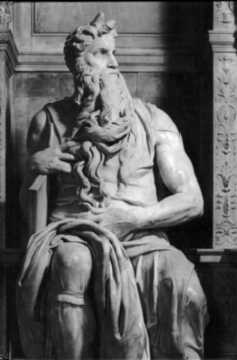 |
The name of Moses occurs in the OT 766 times (see BibHeb1K). Moses was 26 generations from Adam (i.e. Adam's 25gson). During the Egyptian captivity, a new king began to fear the
growing population of his Hebrew slaves. He ordered the execution of all newborn boys. Jochebed hid Moses for 3 months, but eventually made a basket and floated him in the Nile, while his older sister Miriam kept watch. He was found and later adopted by Pharaoh's daughter (Nefertiti?). At age 40, Moses began to sympathize with the plight of his own people, even killing an Egyptian for beating a Hebrew. Fearing punishment, he fled to Midian, marrying Zipporah. One day as he led his flock near Mt Horeb, an angel of God appeared to him in the fire of a burning bush. God instructed Moses to lead his people out of Egypt, with Aaron's help. Since Pharaoh refused to let them go, God sent a series of 10 plagues (Nile to blood, frogs, gnats, flies, k. livestock, boils, hail, locusts, darkness), culminating in the killing by the Angel of Death of the firstborn of each family not covered by the 'passover' blood on the doorpost. As Pharaoh's own son had died, he told Moses to take his people and leave quickly ('take as much as you want'). He later reneged and pursued them to the Red Sea. God blocked their path by a pillar of fire, later parting the Red Sea so the Hebrews could cross, but later killing all the Egyptians. God delivered his law to them via Moses at Mt Sinai. But because of their sin, the God made the people wander in the desert for 40 years before finally leading them to the Promised Land. Because Moses had struck a rock, rather than speak to it as God had instructed, to bring forth water from it, he was not allowed to cross the Jordan River and "God took him" on Mt Nebo (in modern day Jordan). From there, Joshua was appointed as their new leader, and the Israelites entered Canaan to begin their 7-year conquest of the land of Canaan i.e. became Ivrit = to cross over [Jordan] = root rb[ = Hebrews (or does 'cross over' refer to Red Sea parting? See Strong's #5674, but also #5680 which translates it as 'Eberite' i.e. descendent of Eber #14,
hmmm, double meaning? play on words?).
See Cecil B DeMille's famous 195x movie The Ten Commandments for a dramatic presentation of the story
of Moses.
Ussher dates:
1571 Moses born
1556 Cecrops, an Egyptian, transported a colony of the Sais into Attica and there set up the kingdom of the
Athenians
1538 Chaldeans defeated in war, Arabians rule Babylon for 216yrs until Belus the Assyrian, 1rst king of
Arabians Mardocentes r45yrs aka Merodach, Marduk, later divinized by Babylonians
1531 Moses 40yo, visits Hebrew bros, k. Egyptian, flees to Midian, m. Zipporah
1491 God appears to Moses [80yo] in burning bush, calls him to Egypt
Tue 4/5 May 1491 1rst-born of all Egypt killed at midnight by 'Angel of Death', Hebrews leave, exactly 430yrs
from 1rst pilgrimage of Abraham's departure from Canaan to the day they left
Wed 21 Apr 1490 tabernacle set up, filled w/God's Shekinah glory [exactly 125 28yr cycles before Th 21
Apr 2011, hmmm (4/21 is Ussher's already-corrected Gregorian date)]
Tue 4 May 1490 Jews celebrate 1rst (erev) Passover
1484 Egypt named after Aegyptus, whose bro Danaus flees to Greece
1452 after wandering 37yrs, Israelites go from Kadesh-Barnea to Eziongeber, time in wilderness 5 days short
of 40yrs, Balaam's curse, Moses passes 'baton' to Joshua
1451 Moses dies on Mt Nebo [120yo], overlooking promised land, cross over, Jericho taken
David is a key reference figure in the formula: Adam to Noah [#10] in 10 generations, Noah to Abraham [#21] 10g, [Moses #26] Abraham to David [#33] 14g, David to Josiah [#49, i.e. Babylonian capitivity] 14g, Josiah to Jesus [#63/75] 14g, for a total of 62 generations from Adam to Jesus in around 4K yrs (see Bible.html, Matt 1:17).
Chuck (Charles R.) Swindoll has written more than 30 best-selling books, including the "Great Lives from God's Word" series, including Job [~#20] (2004), Moses [#26] (xxxx), David [#33] (1997),
Elijah [~#38] (xxxx), Esther [~#41] (xxxx), Joseph [#62] (xxxx), Jesus [#63]
(Thomas Nelson, 2008, 308pp, SBC), Paul [#64] (xxxx). The 9th volume in the series is "Fascinating
Stories of Forgotten Lives" (xxxx).
Jeff Sypeck's 2006 book Becoming Charlemagne: Europe, Baghdad, and the Empires of AD 800
(HarperCollins, Mustang) mentions the '9 worthies' compiled by Medieval scholars: 1 Joshua c1300 BC, 2
Hector [Troy] c1200 BC, 3 David c1000 BC, 4 AlexGrt d332 BC, 5 Judas Maccabeus 'the hammerer' c160s BC, 6 Julius Caesar 1C BC, 7 King Arthur c450-519 AD, 8 Charlemagne c750-814 and 9 Godfrey of Bouillon famous in 1st 1097 Crusade. i.e. they were all successful empire builders, mostly Christian but also classical or Jewish.
The 8 covenants: Edenic, Adamic, Noahic, Abrahamic, Mosaic, Palestinian, Davidic, New [same as ? ZPEB v1]
(Scofield Bible p1)
The 4 OT themes: election, covenant, law, exodus (EHB p122).
The 6 dispensations: infancy (creation to Noah), childhood (Noah to Moses), adolescence (Moses to Prophets)
and youth (Prophets to Christ), manhood and old age (Christian era), renovation (millenium), 'fullness of time' (eternity) (ZPEB v2 p145).
There have been only 3 times in history [human i.e. not incl. creation] when God provided 'a great outpouring' of 'signs and wonders' to emphasize His presence in events in a special way: 1) Moses [#26] and the Exodus 2) the events surrounding Elijah (875-48 BC ~#38) / Elisha (848-797 BC ~#39) 3) Jesus [#63/75] and His ministry. Jesus said that evil generations demand signs and wonders (Matt 12:39), but we could add that stupid ones ignore them (hmmm, either charismatics are driven by evil or non-charismatics by stupidity? Does this age qualify as 4th great age of S & W? Hmmm).
At the transfiguration, Jesus appeared with Moses and Elijah (~#38, Matt 17, Mark 9,
Luke 9). Elijah's importance in God's plan for the ages is apparent from 1) this and also 2) his predicted
reappearing before 'the great and terrible day of the Lord' (Mal 4:5) and 3) his avoidance of death via
'translation' to heaven along with Enoch (#3, Gen 5:18-24, 2 Kng 2:11, ZPEB v2 p284).
In the OT, only Abraham (2 Chron 20:7, James 2:23) and Moses (Ex 33:11, Isa 41:8) were
privileged to be called 'a friend of God,' now accorded to every believer who abides in Jesus. The
common thread is obedience to God's Word (John 15:10-4, RBC DB 29 Feb 08).
In 1 Tim 6:11, Paul uses the title 'man of God' to describe Timothy. This is a title most often used of Moses (Deut 33:1; Josh 14:6; 1 Chron 23:14; 2 Chron 30:16; Ezra 3:2). Others who have been described this way are David (2 Chron 8:14; Neh 12:24,36), Elijah (1 Kngs 17:18,24; 2 Kngs 1:9,13), and Elisha (2 Kngs 5:20). In the OT, it is also used to designate any prophet or spokesman of God (1 Sam 2:27; 9:6; 1 Kngs 13:1). In 2 Tim 3:17, Paul uses it to describe the Christian (ODB 29 Aug 08).
There are many views of OT timing for e.g. Abraham's visit to Egypt, Joseph's arrival there, the Exodus, etc. Most liberals seemingly assume a later c1290 BC Exodus (from Ramesses the Great e.g. the movie 'The 10
Commandments'), while conservatives (e.g. Ussher, Merrill F Unger [AOT], ? Merrill [HSOT], ...) assume an earlier 1441 BC Exodus, from Amenhotep II, son of the famous Thutmose III, w/Hatshepsut rescueing Moses from the Nile (1491 for Ussher). But now here's David M Rohl with his 1995 Pharaohs and Kings: A Biblical Quest (Crown, FHL, hmmm, video also produced, try to see it), who proposes to rearrange things thus (focusing on Joseph, Moses, Joshua, Saul, David and Solomon): Hebrew sojourn in Egypt began in late 12th dynasty, continued thru most of 13th, lived and worked at Avaris in Goshen; Joseph was vizier under Amenemhat III (12th, son of Senusret III), the most powerful Pharoah of the Middle Kingdom, and continued in that office thru reigns of 1rst few rulers of 13th dynasty; the Exodus Pharoah was Dudimose, 36th in 13th dynasty; the Hyksos came AFTER the Hebrews left and were Amalekite tribesmen who migrated NW from N Arabia thru Sinai to Egypt (fought w/Hebrews en route during 40yr wilderness wanderings); the 'Habiru' of the Amarna letters were followers of David during his exile from Saul's court and extending to his 7yr reign from Hebron before capturing Jerusalem; David was contemp w/ Akhenaten, Tut, Ay and Horemheb (he forged Israel when Egypt was weak and Mitanni were declining i.e. under Hittite/Assyrian pressure); the United Kingdom of Israel was c1250, not c1000 (and invading [Heb.] Shishak probably Ramesses II); Solomon's Egyptian wife was probably the dau of Horemheb of the 18th dynasty; solar eclipse of 9 May 1012 BC confirms Amarna period was late 11C BC, not mid-14th as usually assumed; 18th dynasty began 1194 BC, NOT c1570 (Ahmose). His dates include: 1683 BC Joseph arrives in Egypt, Amenemhat III r1682-36, 12th dynasty ends 1633, Dudimose 1448, Exodus 1447. Hmmm, need to read more.
After a discussion by John Wenham of biblical population numbers in which it is concluded that actual numbers were likely much less (1/10) than those literally shown in the Bible [e.g. 'thousands' probably means 'cmdrs of military 1000s', so from 70 in Joseph's time to 2-3M (72K) at Exodus, 5M (470K) in David's time], he says "the figures of the Levites seem consistently to have collected an extra [zero]. The mystery of Plato's Atlantis has been solved by recognition of this same numerical confusion. Plato obtained from Egyptian priests what now turns out to be a detailed account of the Minoan civilization and its sudden end. But as all the figures were multiplied by a factor of 10, the area was too great to be enclosed in the Mediterranean, so he placed it in the Atlantic; and the date was put back into remote antiquity, thousands of years too early" (EHB p192).
On the idea that the Hebrews inspired a religious reform in Egypt shortly after the Exodus, H V F Winstone in Uncovering the Ancient World (Facts on File, 1986, FHL p224-6) says "the stone-inscribed king lists of Seti and Rameses II from the temples of Abydos had omitted the names of Hatshepsut, the queen-regnant, and several of the male monarchs of the 18th Dynasty. There had crept into the [pre-hellenic] recollection of Greece the names of King Amenophis III and his queen ... [but the rest had been expunged from the Egyptian record, having been considered] 'heretical' ... Akhenaten introduced ... a new concept of religion, that of
Aten worship, or the cult of the sun disc. For almost 2k yrs Egypt had been a land of polytheistic worship; devout, conservative, and resentful of revolutionary ideas. Its art was comfortable, stable ... stylistically uniform ... Amenophis IV ... succeeded [his] father Amenophis III, the monarch of what has been called 'Egypt's golden age' ... [of] diplomacy and trade ... There is evidence that the monotheistic cult of the solar disc, w/its legend of rays terminating in hands representative of the divine power, ascendant over
all men and all things, had flourished under Amenophis III. Indeed there is evidence that Hatshepsut, the female monarch who called herself 'king' was the instigator of the unorthodoxies which beset the land after the reign of the youth Tuthmosis II, whose predecessor Tuthmosis I had [extended the] empire to the Euphrates in the 16C BC ... Amenophis IV made Aten-worship the official religion and changed his name to Akhenaten, the Servant of Aten. Such an affront to the priesthood was unlikely to go unchallenged. Perhaps the heresy of Aten worship had its origin in that obscure period of Hyksos rule which followed the 12th Dynasty, the period of feudal kings who controlled the Nile flood, conquered far and wide, pacified almost all the known world,
and whose name - Khyan - [was found all over e.g. in Crete, Baghdad, among Hittites] ... Economic forces inevitably played a part in bringing about these dramatic changes in Egyptian civil, military and religious fortunes over a period of almost 400yrs until the old orthodoxy was rivived under Rameses I, the founder of the 19th Dynasty, in c1320 BC". He explains that Egyptian success was based on 1) gold, 2) copper, "the essential ingredient of bronze and civilization" which came mostly from Cyprus, "the island which either gave to or received its name from the metal" and 3) tin, "the other ingredient of bronze, also imported, perhaps from England". Ahmose I, founder of the 18th Dynasty, expelled the Hyksos and restored "imperial pride [which] went hand in hand w/a return to the old gods. The heresy which probably began conspiratorially under a woman 'king', continued briefly under Akhenaten's co-regent and sucessor Smenkhkare. But under the next Pharoah, the boy-king Tutankhamen, normality was restored, and the nation reverted to its many gods" (227). Later generations then expunged the record of the 'heresy'.
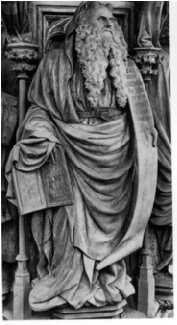
Moses, by Claus Sluter, Dijon; 1296-1405
(MPAN
p149) |
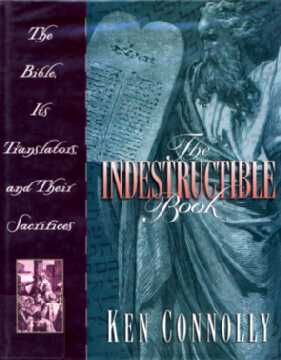
TIB, Baker, 1996, 192pp, Mustang |
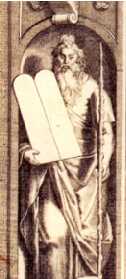
detail from Title page of 1611 KJV
(TIB p167) |
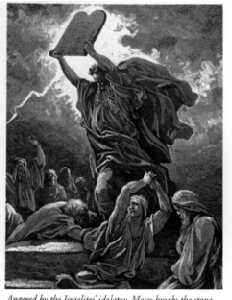
Gustave Dore's 18xx engraving (WWIB p217) |
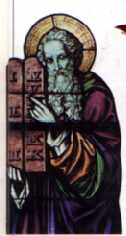
from WWIB cover
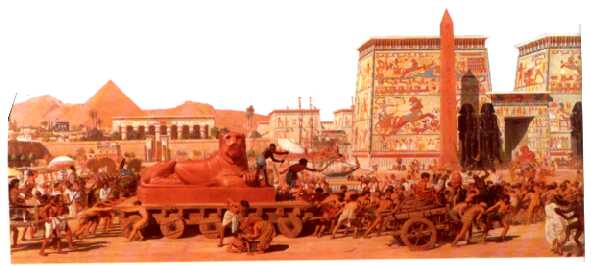
A drawn detail of Sir Edward Poynter's 19C painting (BL p12)
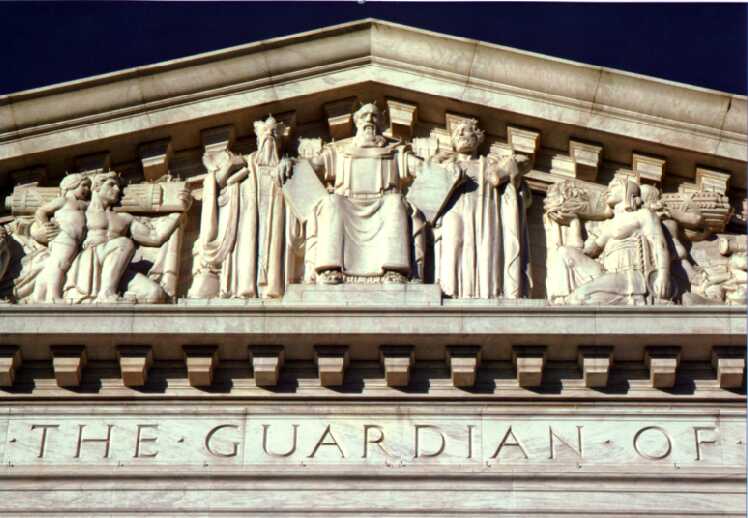
detail of sculpture over ? building including Moses, "Justice The Guardian of
[Truth?]" (from Heritage Foundation's 2008 calender)
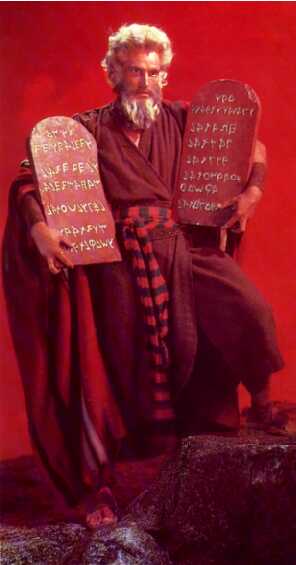
Charlton Heston as Moses in The Ten Commandments (1956)
directed by Cecil B. de Mille (1881-1959) w/costumes by Edith Head
(Testament, John Romer, Henry Holt, 1988, 367pp, FHL, p328+)
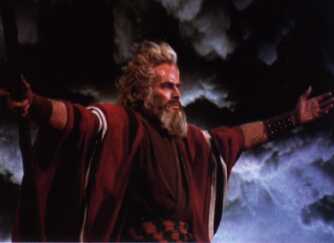
Charlton Heston as Moses parting the Red Sea (Economist obit 4/12-8/08 p95)
Here are the 10 Commandments in Hebrew, as traditionally abbreviated and
full text versions.
Contemporary Events:
- cf Abram for earlier events
- 2160-1500 Minoans 'rule the seas'
- 1950-1651 BC Old Babylon #1
- 1925 BC Hittites [briefly?] conquer Babylon (BN HT, tho their apogee is MUCH later: c1344-22 BC)
- r1878-60 BC 18yrs Sesostris III (12th Dynasty, MK) likely pharaoh of Joseph
- 1860 BC Stonehenge begun in Britain (BN HT), legendary fnding of Babylong by Amorites (WWiB p37)
- c1850-c1750 Mitanni apogee
- 1792-c1350 BC Old Babylon (Hammurabi r1792-52)
- 1760 BC Shang Dynasty founded in China (BN HT)
- c1700 BC Phoenicians develop 22-letter alphabet (WWiB p39, based on Hebrew?)
- 1674-1535 Hyksos invasion/rule (Ussher says began 2084 BC, 302yrs earlier, hmmm)
- 1628 BC Volcano erupts at Thera (Santorini) ending Minoan civ (WWiB p39)
- c1595 BC Hittites sack Babylon, ending Old Babylonian Kingdom (WWiB p39)
- r1550-25 BC 25yrs Ahmose I (18th Dynasty, begins NK) likely pharaoh who 'knew not Joseph'
- 1539-1069 New Kingdom Egypt (#1 1600-1300)
- c1500 BC Mohenjo-Daro (city) in Indus Valley destoyed (BN HT)
- 1491 (We* 5 May) Exodus acc. to Ussher (Thutmose II r1492-79 BC 13yrs 18D, wife Hatshepsut)
- c1473 BC Hatshepsut becomes Egypt's 1st female pharaoh (WWiB p42)
- c1458 BC Thutmose III assumes sole cntl of Egypt, leads 1st of 16 campaigns into Canaan c1455, his general
Djehuty captures Joppa c1445 (WWiB p42)
- c1400 BC Knossos destroyed by fire (Thera/Santorini eruption? or 1628 BC); Tyre, Byblos and Sidon emerge as
leading [Phoenician] trading centers (WWiB p43)
- 1366 BC Assuruballit I enthroned in Assyria, begins (Old) Assyrian rise, #1 1300-1000
- r1352-34 BC 18yrs Akhenaton (aka Amenhotep IV, 18th Dynasty, NK, moves capital to Amarna), wife Nefertiti,
brief period of sun-cntr'd monotheism (influenced by Moses?)
- c1344-22 Hittite apogee under King Suppiluliumas
- r1333-24 BC 9yrs boy-king Tut succeeds Akhenaton, restores old religion
- c1290 BC 1st garrison city built by Israelites on order of Seti I (WWiB p50)
- c1285 BC King Adadnirari I fnds (Old) Assyrian Empire (WWiB p84)
- r1279-13 BC 66yrs Ramesses II 'the Great' 19D, builds Abu Simbel ... Sidon flourishes as great Phoenician
port
- 1275 Battle of Kadesh [Ram. II] v. Hittites (BN HT says 1298, cf 1rst in br-100db)
- c1270 BC 2nd garrison city built by Israelites on order of Ram. II (WWiB p50)
- [c1250 alt late date for Exodus under Ramesses II]
- c1259 BC Egyptian treaty w/Hittites, 1st peace treaty in history (WWiB p51)
- c1256 BC Abu Simbel Temple completed (WWiB p51)
- c1250 BC Egyptians build a canal from the Nile to the Red Sea (WWiB p84)
- c1230 BC Israelites destroy Hazor (WWiB p85, hmmm, assumes 'late' exodus)
- 1213 BC Ramesses II dies, succeeded by Merneptah (WWiB p51)
- 1207 BC 'Victory slab' of Merneptah mentioning Israel (WWiB p85)
- 1193 Trojan War, city of Troy destroyed by Greeks (see Homer's 'Iliad', 'Odysseus')
- 1175 Egypt and other nations invaded by 'Sea Peoples' (hmmm, Trojans? BN HT says 'Philistines, Greeks,
Sardinians and Sicilians', but defeated by Ramesses III)
- c1140 BC 1st Phoenician colony in Africa at Utica (WWiB p89)
- c1125 BC Israelites and Canaanites clash near Megiddo (WWiB p89)
- c1124 BC [Old] Nebuchadnezzar captures Babylon (WWiB p93, an earlier one v. sacker of Jerusalem 586
BC!)
- c1120 BC 'Dark Age' of Greece begins (WWiB p93, due to Sea Peoples?)
- c1103 BC Phoenicians develop alphabetic script (WWiB p93, based on Hebrew?)
- c1100 BC Dorians (from N) capture Mycenaean kingdom, Shang Dynasty overthrown by Zhou (WWiB p94)
- cf David for later events
From 1250-1100 BC, the E Mediterranean was in turmoil [as] a mass movement of peoples [attacked the area] and some of the great Bronze Age civilizations, including the Mycenaeans and Hittites, were violently destroyed
by unknown enemies. Only Egypt was strong enough to fend [them] off, calling them 'Sea Peoples' ... Pharaoh
Ramesses III defeated a great seaborne invasion by the Sea Peoples in the Nile delta in 1178 BC, later
depicting the victory in temple wall carvings showing a captive people called the 'Peleset'. They later
settled on the coast of Canaan, where they gave their name to Palestine. We know them from the Bible as the
Philistines (p37, History Year by Year, DK, 2013, FHL; 5 main cities were Ashkelon, Ekron, Ashdod, Gaza and
Gath).
* 5 May 1491 BC was, according to modern reckonning, a We i.e. exactly 125 28yr cycles before We 5 May
2010
Sources:
- The Holy Bible
- WWIB = Who's Who in the Bible: An Illustrated Biographical Disctionary, ed. Dietrich Gruen,
Publications Intl, 1995, 320pp, Mustang.
- MPAN = Medieval Panorama, ed. Robert Bartlett, Thames and Hudson, 2001, 336pp, FHL.
- BL = Bible Lands, Jonathan N Tubb, DK [Dorling Kindersley], 1991, 64pp, FHL.
- EHB = Eerdmans' Handbook to the Bible, ed. David Alexander, 1973, 680pp, FHL.
- ToH = Timeline of History, author?, publisher?, year?, SBC.
- BN HT = History's Timeline, Barnes & Noble, 1981, own.
- HAW = The History of the Ancient World, Susan Wise Bauer, W W Norton, 2007, Mustang.
- WWiB = Who's Who in the Bible, Jean-Pierre Isbouts, National Geographic, 2013, Mustang.
- see also Egypt, ToN, br-lciv, ...











